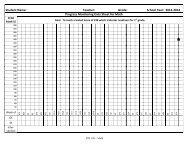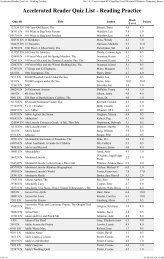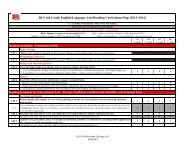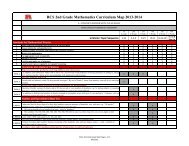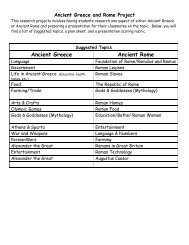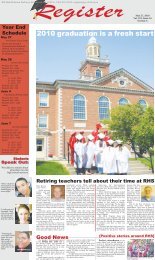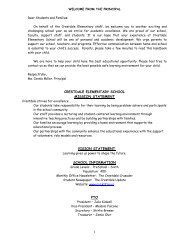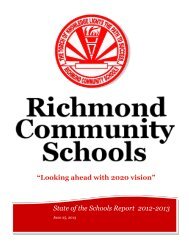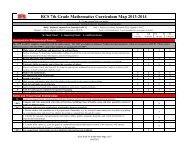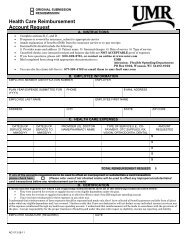Ubd Unit Indian Boarding Schools.pdf - Richmond Community Schools
Ubd Unit Indian Boarding Schools.pdf - Richmond Community Schools
Ubd Unit Indian Boarding Schools.pdf - Richmond Community Schools
Create successful ePaper yourself
Turn your PDF publications into a flip-book with our unique Google optimized e-Paper software.
standards for success.<br />
Issue rubrics to the<br />
students.<br />
STAGE 3 – Design learning activities<br />
Use the WHERETO model to identify the type – but not the sequence – of instructional activities required to<br />
promote the desired results. Following the WHERETO model is an optional calendar for actually scheduling the<br />
sequence of learning activities. Note that assessment activities (the second “E” and to some extent the “R” in<br />
WHERETO) are embedded throughout the unit.<br />
WHERETO<br />
W<br />
H<br />
E<br />
R<br />
E<br />
T<br />
O<br />
How will you ensure that all<br />
students know where they are<br />
headed in the unit, why they are<br />
headed there, and how they will be<br />
evaluated?<br />
How will you hook students at the<br />
beginning of the unit?<br />
What events will help students<br />
experience and explore the big ideas<br />
and questions in the unit? How will<br />
you equip them with needed skills<br />
and knowledge?<br />
How will you cause students to<br />
reflect and rethink? How will you<br />
guide them in rehearsing, revising,<br />
and refining their work?<br />
How will you help students to<br />
exhibit and self-evaluate their<br />
growing skills, knowledge, and<br />
understanding throughout the unit?<br />
How will you tailor instruction to<br />
meet student need in readiness,<br />
learning style, and interest while<br />
remaining true to the desired result?<br />
How will you organize learning experiences<br />
to maximize engagement and understanding<br />
and minimize misconceptions?<br />
“W” Ideas<br />
Introduce the essential questions and discuss their thinking as it<br />
stands at the beginning of the unit. Discuss culminating<br />
performance task.<br />
“H” Ideas<br />
Begin by showing a photograph of your class to your class. What<br />
differences/similarities do they see?<br />
“E1” Ideas<br />
Exploring quality children’s literature on the topic of Native<br />
American <strong>Boarding</strong> <strong>Schools</strong><br />
Examining and analyzing students’ of their time at a boarding<br />
school<br />
Create a fictional diary account of a child at a<br />
boarding school<br />
“R” Ideas<br />
Write, pair, shares<br />
Anecdotal notes in group discussion<br />
“E2” Ideas<br />
Exit-tickets<br />
Rubric for performance task<br />
“T” Ideas<br />
Most text is accessible as it is read aloud to the students. Other text<br />
will be done with partner support. The performance task is open for an<br />
addition of artwork with the diary entries (ledger art would be<br />
particularly interesting). Poetry form could take the place of diary<br />
entries<br />
“O” Ideas<br />
Continually refer to essential questions and new understandings<br />
throughout unit as their understanding deepens<br />
Students reflect on the ways in which they can support diversity in their<br />
school<br />
6



